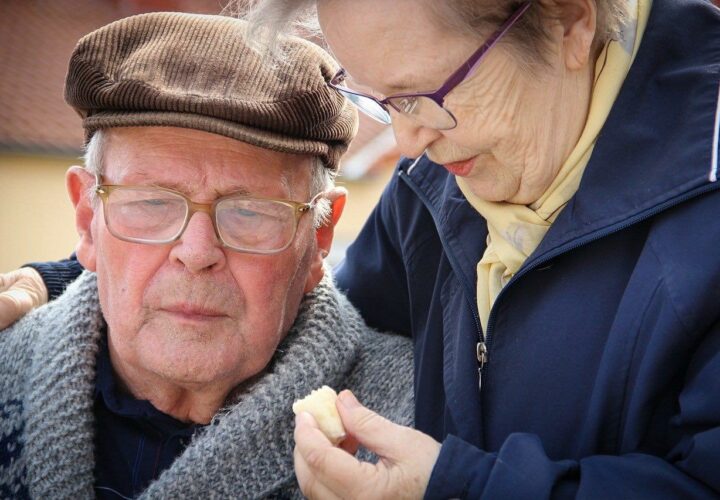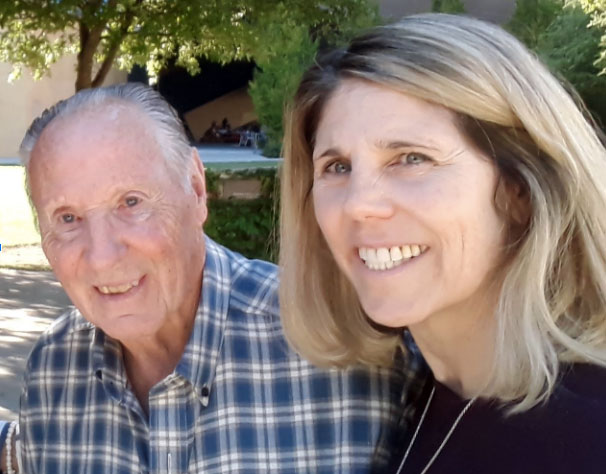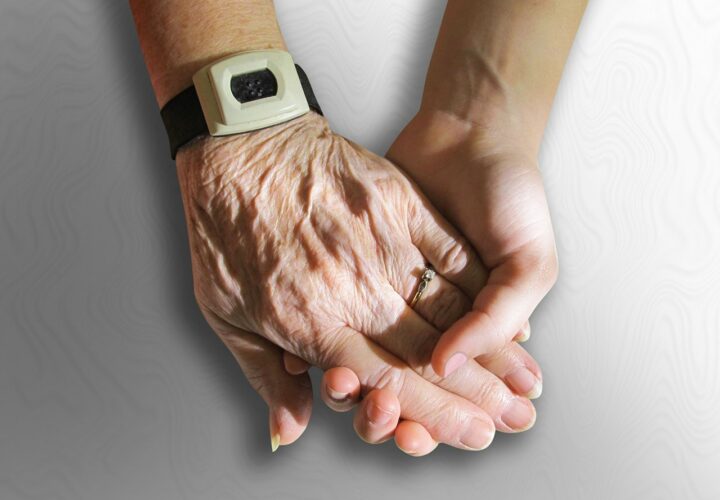Essential Caregiver Programs have allowed some people to reunite with loved ones in American long-term care facilities after months of pandemic isolation, but for most, the painful separation continues.
For Mary Daniel, being designated as an “Essential Caregiver,” a position now recognized by a handful of states, including her home state of Florida, meant that she could quit her job as a dishwasher at her husband’s assisted living facility. Desperate to see her husband, Steve, who has early-onset Alzheimer’s, Mary had taken the job as a creative workaround allowing for the two to see each other despite visitation restrictions.
Mary told Being Patient, “I quit my job on September 1st when the Governor signed the order allowing me to enter through the front door!” Mary explained that she has since been able to visit Steve every evening. She was required to complete a PPE video series and must wear a face mask, but can touch him, hug him, and stay for as long as she wants.
In March of 2020, long-term care facilities across the U.S. closed their doors to visitors in an attempt to protect their vulnerable residents from COVID-19. Nearly one full year has passed and millions of vaccines have been administered, yet most families are still unable to reunite with their loved ones. This devastating, persistent isolation is of particular concern to the dementia community: 75 percent of individuals living with Alzheimer’s at the age of 80 are expected to live in a nursing home, compared with only 4 percent of the general population at this age, and studies show social isolation has a detrimental impact on the elderly. Isolation and loneliness are associated with about a 50 percent increased risk of dementia and can also exacerbate Alzheimer’s-related memory impairment.
The Centers for Medicare and Medicaid Services (CMS) is the entity providing formal COVID-19 guidance for visitation in long-term care facilities that is being carried out throughout the country. The latest memorandum released on September 17, 2020 states that indoor visitation can only occur in a facility if there have not been any new resident or staff COVID-19 cases within the past 14 days, and the positivity rate in the county is lower than 1 in 10 individuals.
According to caregivers and loved ones, even if facilities are fortunate enough to remain COVID-free for a period of time, visits are kept on a tight schedule and only offered on a limited basis as there are often hundreds of residents to account for. Many families viewed vaccination as the light at the end of the tunnel, finally allowing for increased access to their loved ones. As of January 2021, as many as about nine out of ten residents in skilled nursing home facilities had received at least one dose of a COVID-19 vaccine. But despite this, so far, families say little has changed. CMS has not modified visitation guidance in the slightest, keeping visitation contingent upon case rates rather than vaccination rates.
In light of stringent visitation restrictions and their impact on the psychosocial wellbeing of residents, a handful of states have authorized Essential Caregiver programs like that which allowed Mary and Steve Daniel to finally spend time together in person. According to Argentum, a national association dedicated to supporting senior living communities, the purpose of Essential Caregiver programs is “to provide residents, whose health or well-being may be impacted by the unintended consequences of prolonged physical separation and social isolation, [with] visits from family members or other trusted individuals for the purpose of providing care, assistance with activities, companionship, [and] emotional and social support.”
One to two family members or trusted individuals who, before the onset of the pandemic, were regularly engaged with a resident and who provided companionship or assisted with activities of daily living are eligible for Essential Caregiver designation in select states.
But, so far, each state handles these new programs a little differently, and within each state, each facility may have their own, subjective policies in place. An important distinction for Mary and Steve Daniel in Florida is that Steve’s assisted living facility allows Essential Caregivers to visit even if members of the staff or other residents in the facility test positive for COVID-19. Meanwhile, many other facilities that recognize Essential Caregivers continue to observe CMS guidance prohibiting any entry for 14 days after a new case or if their county case rate surpasses 10 percent, no different from any other visitor.
In fact, long-term care facilities in states with established Essential Caregiver programs are able to decide whether or not they wish to adopt the provided guidance. Facilities have the freedom to prohibit or drastically limit Essential Caregiver entry at their discretion, or to completely decline to implement the program.
Teri Voras, who also resides in Florida, knows this stipulation all too well as visitation access to her mother, who suffers from Alzheimer’s Disease, was fleeting. Teri told Being Patient, “The challenge I face is that the rules keep changing and the terminology keeps changing. Orders stated the Essential Caregivers were allowed in regardless of staff testing positive…and two months ago they had isolation and I was allowed in. They are now telling me I am not allowed in until [the facility reaches] 14 days COVID-free.”
Mary Nichols, of Texas, is also recognized as an Essential Caregiver for her mother who is living with Alzheimer’s Disease. Guidelines in Texas allow for each long-term care facility resident to have two designated Essential Caregivers, both of which are permitted to visit their loved one for up to two hours every day.
However, Nichols told Being Patient that her mother’s nursing home only grants Essential Caregivers entry once or twice per week. If a resident has only one Essential Caregiver, the caregiver is allotted two 60-minute visits per week, and if a resident has two Essential Caregivers, each caregiver is only allotted one 60-minute visit per week.
Another Texan, Emmy Sawvel, an Essential Caregiver for her dear friend of 21 years, has only been able to visit two times since March. Her loved one’s facility doesn’t allow visits on weekends, and Emmy is unable to take time off from her job during the week as she’s an essential worker.
Despite their inconsistent execution so far, Mary Daniel is a staunch advocate for widespread adoption of Essential Caregiver programs. “It’s been extremely successful,” she said, “and it’s time the rest of the U.S. follows our lead.”
Unfortunately, most states have yet to roll out the Essential Caregiver designation. Currently, it is available in Indiana, Minnesota, Missouri, Oklahoma, Texas, Florida, and New Jersey. However, change may be coming soon to New York, Connecticut, Pennsylvania, Ohio and Rhode Island among others, as politicians across the country have sponsored bills in hopes of starting Essential Caregiver programs in their state. In Indiana, lawmakers are considering an additional bill that would require every skilled nursing facility in the state to fully participate in their Essential Caregiver program. The proposed legislation would also allow for Essential Caregivers to enter their loved one’s facility regardless of new COVID-19 cases in the building or a high county positivity rate.
Mary knows the wait is painful. For those separated from their loved ones in long-term care facilities, she started a Facebook group “Caregivers for Compromise – because isolation kills too!” — an excellent resource for support. You can also connect with others in your area by joining the Caregivers for Compromise group in your state. These groups provide information on how to advocate for your loved one and for the implementation of worthwhile Essential Caregiver programs.



